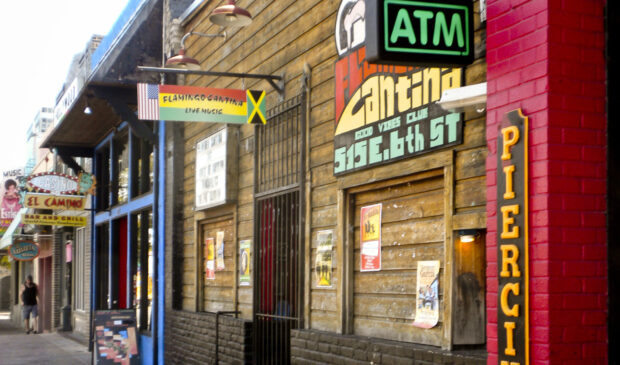Council approves taller buildings in part of Sixth Street entertainment district
Monday, July 24, 2023 by
Chad Swiatecki City Council has approved an increase in building height for a portion of the East Sixth Street entertainment district that has been targeted for redevelopment by a Dallas-based real estate firm.
The ordinance amendment approved Thursday after a public hearing will allow buildings on the 500 and 600 blocks of East Sixth Street – the stretch between Neches and Sabine streets – to reach a maximum of 140 feet in height, or whatever the limits of state Capitol View Corridor laws will allow.
The increase from the long-standing 45-foot height limit in the largely historic entertainment district will allow Stream Realty to move forward with plans to erect an office building and a boutique hotel on a handful of the roughly 40 properties the company has acquired over the past five years.
Council initiated the change last June, with the Historic Landmark Commission giving its approval for the new construction if three requirements are met: the first 15 feet of historic facades are retained, with new construction recessed behind those facades; a certificate of appropriateness is granted for construction on historically significant structures; and consideration be given to placing tax caps on legacy businesses that could be displaced by the increase in property values expected as the district is improved.
Stream’s plans for the district represent the most cohesive and prolonged effort to transform one of the main arteries of downtown Austin, which for decades has been known as a nightlife center because of its high concentration of shot bars amid a handful of music and entertainment venues.
Along with the taller buildings that are expected to generate strong leasing revenue, Stream’s leaders expect the people occupying those buildings during daytime hours to bring new business to the many other storefronts the company plans to remake as a mix of hospitality and entertainment businesses.
Speaking to the Historic Landmark Commission last year, Stream attorney Richard Suttle said the mix of retail, restaurants and creative spaces would remake the district as “what Sixth Street used to be, where you could actually go down and have a meal and see a show, or listen to live music.”
After the approval, Suttle told the Austin Monitor via text, “The future of (Sixth) Street as we once knew it just got a lot brighter. We can now look forward to a safe and lively (Sixth Street) with 24/7 activity. The good kind. The action today enables the planning of a mix of music venues (and) restaurants along with other beneficial uses that will bring back the vibrancy of our signature street.”
While remaking the district colloquially known as “Dirty Sixth” has long been a goal of civic and business leaders, that effort took on more urgency after a string of shootings happened over several weekends in the summer of 2021. One of those shootings resulted in the death of tourist Doug Kantor, with 13 other people injured.
Council Member Zo Qadri, whose district includes the Sixth Street and Red River nightlife districts, praised the height change and said his office will work with existing businesses to prevent the displacement of music venues and other cultural entities by higher rents as the area becomes more attractive for development.
“This ordinance has a promise of renewing the most famous and most historic quarter in Austin,” he said. “It will unlock opportunities to bring more kinds of uses to what is now a strip of mostly shot bars that sit idle throughout most hours of the day. It will also preserve the historic look and feel of the street, while restoring the mix of businesses and attractions that once made Sixth Street a vibrant and bustling district for people of all ages and backgrounds.”
Qadri added, “I also want to acknowledge the Red River Cultural District’s valid concerns around increasing development pressures that face our treasured venues and local businesses in this part of downtown. My office is committed to working with all stakeholders to find comprehensive solutions that protect our live music culture and promote a welcoming downtown for all Austinites.”
Photo by vxla, CC BY 2.0, via Wikimedia Commons.
The Austin Monitor’s work is made possible by donations from the community. Though our reporting covers donors from time to time, we are careful to keep business and editorial efforts separate while maintaining transparency. A complete list of donors is available here, and our code of ethics is explained here.
You're a community leader
And we’re honored you look to us for serious, in-depth news. You know a strong community needs local and dedicated watchdog reporting. We’re here for you and that won’t change. Now will you take the powerful next step and support our nonprofit news organization?




